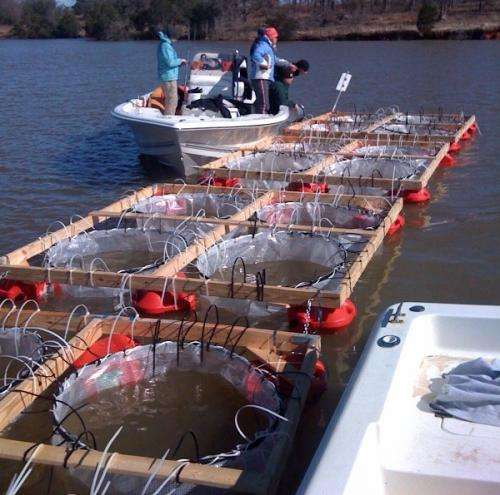Low pH levels can eliminate harmful blooms of golden algae, one cause of massive fish kills

(Phys.org)—Baylor University researchers are one step closer to understanding the algae that causes a substantial number of fish deaths in more than 18 states.
Golden algae, Texas Tide or Prymnesium parvum, as it is known by its scientific name, produces toxins that can severely impact aquatic organisms. Over the past decade, golden algae blooms have been responsible for the death of tens of millions of fish in Texas reservoirs.
To view the study, published in the December issue of Harmful Algae.
Bryan W. Brooks, Ph.D., professor of environmental science and biomedical studies at Baylor and director of the environmental science graduate program and the environmental health science program, and his research team found that neutral pH levels prevented the algae's bloom development and the toxicity of the algae was greatly diminished.
"Our novel findings identify that surface water pH is a very important factor influencing whether harmful algal blooms of Prymnesium parvum will even occur in a lake or reservoir," Brooks said. "In addition to better understanding the ecology and toxicology of this invasive species, this new information promises to support more sustainable environmental management of fisheries and drinking water supplies."
Brooks and his research team conducted two experiments—one during pre-bloom period and another during bloom development—over 21 days to gauge the effect of pH 7 and 7.5 on toxicity of golden algae. The study—in Lake Granbury, Texas, a common site of destructive golden algae blooms—also included untreated lake water with pH of 8.5.
"In the bloom development experiment, acute toxicity to fish was observed in the untreated lake water (pH 8.5) and in the pH 7.5 treatment level as early as Day 7. However, the pH 7 treatment levels remained free from acute toxicity throughout the 21-day study," said Krista N. Prosser, Baylor environmental science graduate student and lead author of the study.
Researchers can now better identify when and where harmful blooms may occur and develop solutions to minimize the impact of golden algae.
"Because golden algae blooms appears to originate in coves that experience lower inflows than the main reservoir stems, coves may represent more reasonable management units to create refuge habitats and potentially preempt bloom formation," Brooks said.
More information: www.sciencedirect.com/science/ … ii/S1568988312001473
Provided by Baylor University















